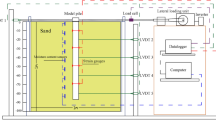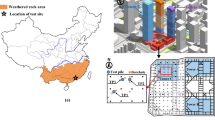Abstract
Negative skin friction on piles represents a severe problem when piles were installed in soft clay due to consolidation process. It reduces the bearing capacity of piles by adding additional load due to drag load developed on piles. Additional settlement due to negative skin friction might produce threatening consequences such as differential settlements or cracks and can cause failure. This study investigates new techniques to construct piles either single or in groups to reduce NSF developed on the pile surface when the pile is subjected to lateral loads at its top. This study was made for both circular pile and square pile. First technique is to surround the pile by a sand socket along pile length from the ground surface till the neutral plan (NP) location. Second technique depended on changing the geometry of pile surface by adding ridges at equal spaces along pile length. Another change was made by creating equally spaced grooves on the pile surface. It was concluded that all the three techniques were effective in reducing NSF induced in the pile surface. For both circular and square piles when subjected to lateral loads NSF was reduced with ratio of (30%) in case of sand socket and ratio of (97%) for ridged and grooved piles. Also, it should be noted that the effect of lateral loads on the values of NSF has no literature.


























































Similar content being viewed by others
Data Availabaility Statement
Some or all data, models, or code that support the findings of this study are available from the corresponding author upon reasonable request. All data, models, and code generated or used during the study appear in the submitted article. No data, models, or code were generated or used during the study. Some or all data, models, or code generated or used during the study are proprietary or confidential in nature and may only be provided with restrictions. Ome or all data, models, or code generated or used during the study are available in a repository online in accordance with funder data retention policies. Some or all data, models, or code used during the study were provided by a third party. Direct requests for these materials may be made to the provider as indicated in the Acknowledgements.
References
ABAQUS. (2014). Abaqus 6.14. Abaqus 6.14 Analysis User’s Guide, 14
Abdrabbo FM, Ali NA (2015) Behaviour of single pile in consolidating soil. Alex Eng J 54(3):481–495. https://doi.org/10.1016/j.aej.2015.05.016
Alipour R, Khazaei J, Pakbaz MS, Ghalandarzadeh A (2017) Settlement control by deep and mass soil mixing in clayey soil. Proc Inst Civ Eng Geotech Eng 170(1):27–37. https://doi.org/10.1680/jgeen.16.00008
Alonso EE, Josa A, Ledesma A (1984) Negative skin friction on piles: A simplified analysis and prediction procedure. Geotechnique 34(3):341–357. https://doi.org/10.1680/geot.1984.34.3.341
Chan SH (2006). Negative Skin Friction on Piles in Consolidationg Ground. 827–836. http://gndec.ac.in/~igs/ldh/conf/2009/articles/V2-0_01.pdf
Chen RP, Zhou WH, Chen YM (2009) Influences of soil consolidation and pile load on the development of negative skin friction of a pile. Comput Geotech 36(8):1265–1271. https://doi.org/10.1016/j.compgeo.2009.05.011
El-Meligy MM, Mahmoud AI, Mohamed SM (2016) Studying the effect of pile-soil interface properties on piles subjected to negative skin friction. N. Y. Sci J 9(3):103–115. https://doi.org/10.7537/marsnys09031617
Fellenius BH (1988) Unified design of piles and pile groups. Transp Res Rec 1169:75–82
Feng Z, Hu H, Zhao R, He J, Dong Y, Feng K, Zhao Y, Chen H (2019) Experiments on reducing negative skin friction of piles. Adv Civ Eng. https://doi.org/10.1155/2019/4201842
Hajitaheriha MM, Jafari F, Hassanlourad M, Hasani Motlagh A (2021) Investigating the reliability of negative skin friction on composite piles. Civ Eng Infrastructures J 51(1):23–42. https://doi.org/10.22059/CEIJ.2020.287489.1607
Indraratna B, Balasubramaniam AS, Phamvan P, Wong YK (1992) Development of negative skin friction on driven piles in soft Bangkok clay. Can Geotech J 29(3):393–404. https://doi.org/10.1139/t92-044
Mahdi Hajitaheri Ha M, Hassanlourad M (2015) (n.d.). Numerical modeling of negative skin friction on single vertical and batter pile
Lee C, Ng CWW (2004) Development of Downdrag on Piles and Pile Groups in Consolidating Soil. J Geotech Geoenviron Eng. https://doi.org/10.1061/(ASCE)1090-0241(2004)130:9(905)
Pakbaz MS, Alipour R (2012) Influence of cement addition on the geotechnical properties of an Iranian clay. Appl Clay Sci 67–68:1–4. https://doi.org/10.1016/j.clay.2012.07.006
Poulos HG, Davis EH (1972) Development of negative friction with time in end-bearing piles. Aust Geomechanics J G2(1):11–20
Randolph MF, Worth CP (1978) Analysis of deformation of vertically loaded piles. ASCE J Geotech Eng Div 104(3):1465–1488
Saha A (2015) The Influence of negative skin friction on piles and pile groups & settlement of existing structures. Int J Emerg Technol 6(2):53–59
Trochanis AF, Worth CP (1988) A three-dimensional non-linear study of piles leading to the development of a simplified model. A technical report of research the national science foundation. Carnegie Mellon, Pittsburgh
Zhang Z, Rao FR, Ye GB (2020) Design method for calculating settlement of stiffened deep mixed column-supported embankment over soft clay. Acta Geotech 15(4):795–814. https://doi.org/10.1007/s11440-019-00780-3
Zhao Z, Ye S, Zhu Y, Tao H, Chen C (2022) Scale model test study on negative skin friction of piles considering the collapsibility of loess. Acta Geotech 17(2):601–611. https://doi.org/10.1007/s11440-021-01254-1
Funding
No funding was received for this work.
Author information
Authors and Affiliations
Corresponding author
Ethics declarations
Conflict of interest
No conflict of interest exists.
Human or animal rights
We further confirm that any aspect of the work covered in this manuscript that has involved human patients has been conducted with the ethical approval of all relevant bodies and that such approvals are acknowledged within the manuscript.
Additional information
Publisher's Note
Springer Nature remains neutral with regard to jurisdictional claims in published maps and institutional affiliations.
Rights and permissions
About this article
Cite this article
shawky, O., Altahrany, A.I. & Elmeligy, M. Improved Pile Geometry to Reduce Negative Skin Friction on Single Driven Pile and Pile Groups Subjected to Lateral Loads. Geotech Geol Eng 40, 4487–4516 (2022). https://doi.org/10.1007/s10706-022-02165-y
Received:
Accepted:
Published:
Issue Date:
DOI: https://doi.org/10.1007/s10706-022-02165-y




